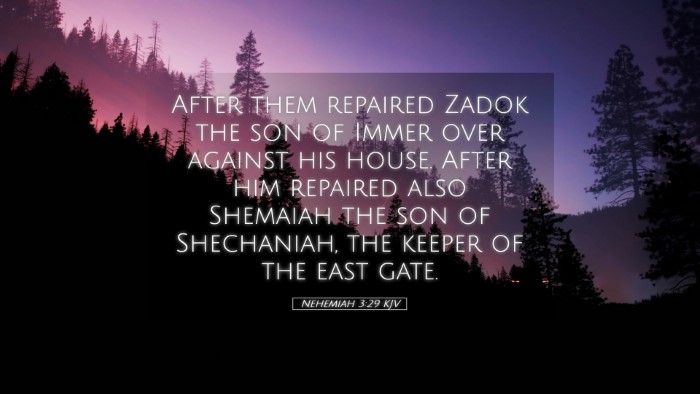Commentary on Nehemiah 3:29
Nehemiah 3:29 states:
"After them repaired Zadok the son of Immer over against his house. And after him repaired also Shemaiah the son of Shechaniah, the keeper of the east gate."
Introduction
The verse presents a glimpse into the systematic work undertaken by Nehemiah and the people of Jerusalem in rebuilding the city walls. Each person's contribution, including Zadok's and Shemaiah's, signifies important elements of leadership, community involvement, and spiritual responsibility.
Historical Context
The Book of Nehemiah is situated around 445 B.C., a period where the Jewish people returned from Babylonian exile to find Jerusalem in ruins. Nehemiah’s leadership is marked by a fervent prayer life and a commitment to the restoration of his homeland.
Commentary Insights
-
Matthew Henry’s Perspective
Matthew Henry emphasizes the importance of personal investment in the work of restoration. Zadok, described as the son of Immer, symbolizes the priests who actively participated in rebuilding efforts. Henry notes that involvement in God’s work is a reflection of spiritual dedication.
-
Albert Barnes’ Perspective
Albert Barnes focuses on the spiritual implications of Shemaiah's designation as the keeper of the east gate. He points out that the gates of a city hold strategic importance both physically and spiritually. The east gate signifies the direction from which the light and new beginnings emerge, echoing the themes of hope and renewal found throughout the restoration narrative.
-
Adam Clarke’s Perspective
Adam Clarke provides a critical analysis of the individuals mentioned in this passage. He suggests that the mention of their names is not merely for historical record but instills a sense of honor and acknowledgment of their service. Clarke emphasizes that every contribution, regardless of perceived significance, is vital in the eyes of God.
Thematic Elements
-
Unity in Purpose:
The participation of various individuals with unique roles signifies a united purpose. This serves as a reminder for contemporary believers to engage in communal efforts towards spiritual and physical restoration.
-
Leadership and Service:
Both leaders and the laity play crucial roles. Leadership is reflected not just in authority but in willingness to serve alongside others. Nehemiah's model for leadership encourages active participation rather than passive oversight.
-
Restoration and Renewal:
The act of rebuilding the walls of Jerusalem extends beyond physical structures. It represents spiritual renewal, wherein every individual’s effort contributes to the overarching goal of restoring faith and community.
Application for Today
The historical account of Nehemiah and the rebuilding of Jerusalem’s wall serves as a powerful metaphor for contemporary challenges faced by the church and believers. The diligence and unity exhibited by the individuals involved is instructive for modern congregations seeking to advance God’s kingdom.
-
Encouragement to Serve:
Just as Zadok and Shemaiah took part in the physical rebuilding, modern believers are encouraged to identify their roles in their local church and community. Whether through teaching, leading, or serving, every action contributes to the collective advancement of faith.
-
Understanding Spiritual Gates:
Understanding the metaphor of gates in our spiritual lives invites believers to consider what needs protection, what needs to be opened to God’s light, and how they can contribute to both safeguarding and new opportunities in their spiritual communities.
-
Valuing Every Contribution:
This passage reminds us that no contribution is too small when it comes to God’s work. Every act of service is vital to the functioning of the body of Christ. Believers are called to appreciate and honor various roles within the church.
Conclusion
Nehemiah 3:29 symbolizes the heart of communal effort in rebuilding not just walls, but lives and faith itself. The lessons drawn from this passage resonate with the call towards unity, service, and the recognition of each individual’s vital contribution to the work of God’s Kingdom. Encouraging active participation and demonstrating that each person’s role matters is an essential takeaway for pastors, theologians, and students of the Bible.


